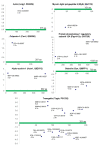Differential Post-Translational Modifications of Proteins in Bladder Ischemia
- PMID: 38255188
- PMCID: PMC10813800
- DOI: 10.3390/biomedicines12010081
Differential Post-Translational Modifications of Proteins in Bladder Ischemia
Abstract
Clinical and basic research suggests that bladder ischemia may be an independent variable in the development of lower urinary tract symptoms (LUTS). We have reported that ischemic changes in the bladder involve differential expression and post-translational modifications (PTMs) of the protein's functional domains. In the present study, we performed in-depth analysis of a previously reported proteomic dataset to further characterize proteins PTMs in bladder ischemia. Our proteomic analysis of proteins in bladder ischemia detected differential formation of non-coded amino acids (ncAAs) that might have resulted from PTMs. In-depth analysis revealed that three groups of proteins in the bladder proteome, including contractile proteins and their associated proteins, stress response proteins, and cell signaling-related proteins, are conspicuously impacted by ischemia. Differential PTMs of proteins by ischemia seemed to affect important signaling pathways in the bladder and provoke critical changes in the post-translational structural integrity of the stress response, contractile, and cell signaling-related proteins. Our data suggest that differential PTMs of proteins may play a role in the development of cellular stress, sensitization of smooth muscle cells to contractile stimuli, and deferential cell signaling in bladder ischemia. These observations may provide the foundation for future research to validate and define clinical translation of the modified biomarkers for precise diagnosis of bladder dysfunction and the development of new therapeutic targets against LUTS.
Keywords: bladder; ischemia; non-coded amino acids; post-translational modifications; protein profiling.
Conflict of interest statement
The authors declare no conflicts of interest.
Figures




Similar articles
-
Post-Translational Modification Networks of Contractile and Cellular Stress Response Proteins in Bladder Ischemia.Cells. 2021 Apr 27;10(5):1031. doi: 10.3390/cells10051031. Cells. 2021. PMID: 33925542 Free PMC article.
-
Cellular Stress and Molecular Responses in Bladder Ischemia.Int J Mol Sci. 2021 Nov 1;22(21):11862. doi: 10.3390/ijms222111862. Int J Mol Sci. 2021. PMID: 34769293 Free PMC article. Review.
-
Formation of Double Stranded RNA Provokes Smooth Muscle Contractions and Structural Modifications in Bladder Ischemia.Res Rep Urol. 2022 Nov 16;14:399-414. doi: 10.2147/RRU.S388464. eCollection 2022. Res Rep Urol. 2022. PMID: 36415310 Free PMC article.
-
Regulation of Cellular Stress Signaling in Bladder Ischemia.Res Rep Urol. 2020 Sep 17;12:391-402. doi: 10.2147/RRU.S271618. eCollection 2020. Res Rep Urol. 2020. PMID: 32984087 Free PMC article.
-
Molecular Regulation of Concomitant Lower Urinary Tract Symptoms and Erectile Dysfunction in Pelvic Ischemia.Int J Mol Sci. 2022 Dec 15;23(24):15988. doi: 10.3390/ijms232415988. Int J Mol Sci. 2022. PMID: 36555629 Free PMC article. Review.
References
Grants and funding
LinkOut - more resources
Full Text Sources
Miscellaneous

